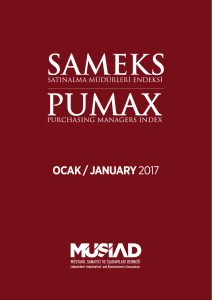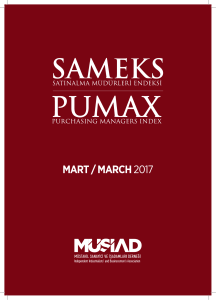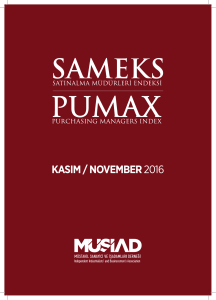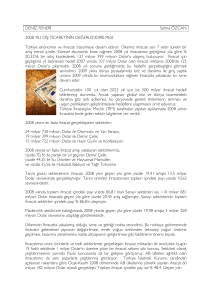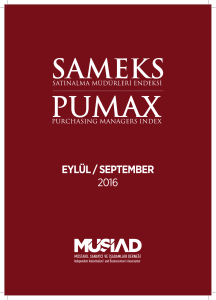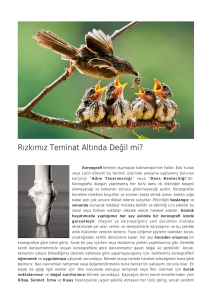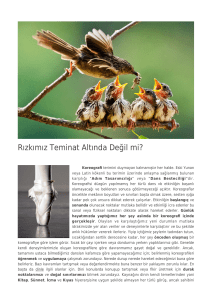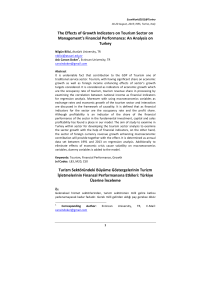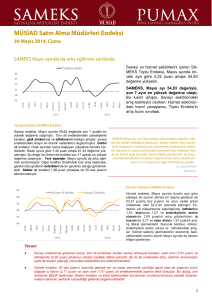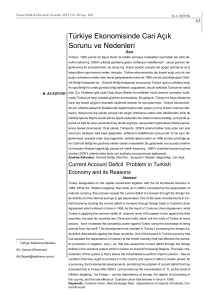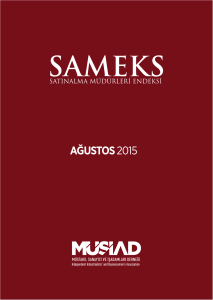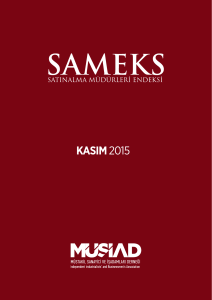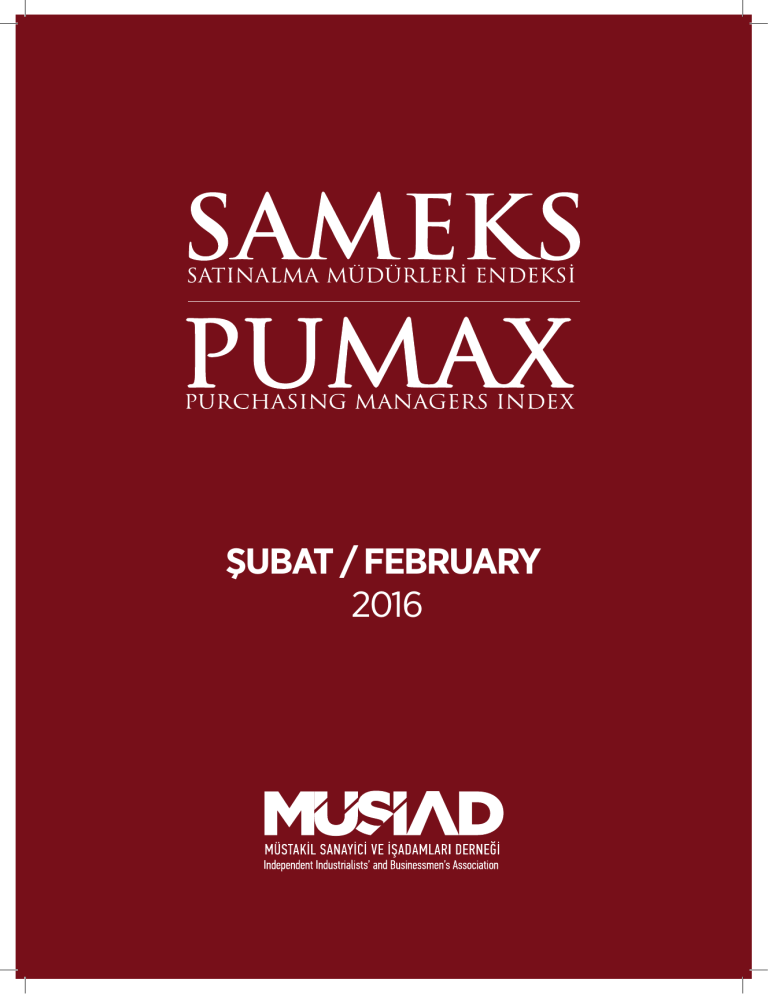
ŞUBAT / FEBRUARY
2016
SAMEKS
1. Sanayi Sektörü SAMEKS Endeksi
PUMAX
1.PUMAX Industry Sector Index
SAMEKS Bileşik Endeksi1 2016 yılı Şubat ayında, bir
önceki aya göre 2,3 puan azalarak 52,3 puana gerilemiştir. Endekste gözlenen bu azalışta; önceki aya
göre, hizmet sektörünün 9,0 puan azalarak 49,9
puana gerilemesi etkili olmuştur. Sanayi sektörü
ise, önceki aya göre 14,1 puan artmış ve Bileşik Endeks’te gözlenen azalışı sınırlandırmıştır.
SAMEKS Sanayi Endeksi, 2016 yılı Şubat ayında,
bir önceki aya göre 14,1 puan artarak 57,9 seviyesine yükselmiştir. Yeni Sipariş (21,1 puan), üretim
(15,4 puan), satın alım (9,3 puan) ve tedarikçilerin
teslimat süresi (7,6 puan) alt endeksinde gözlenen
artışlar, sanayi sektörünün hız kazanmasının en
önemli belirleyicileri olmuştur.
PUMAX Industry Index increase 57.3 in February
Böylece SAMEKS Bileşik Endeksi; 52,3 puanlık değeriyle, üst üste 7 ay 50 referans puanını üzerinde
yer almış ve 2016 yılı Şubat ayında ekonomik aktivitenin canlılığını sürdürdüğüne işaret etmektedir.
Şubat ayında gözlenen bu artış ile; SAMEKS Sanayi Endeksi 50 baz puanının üzerinde yer almış ve
sanayi sektöründe ekonomik aktivitenin canlılığına
işaret etmektedir.
PUMAX Composite Index1 fell down to 52.3 in February 2016 with a 2.3-point decrease compared
with the previous month. The fell down of services industry to 49.9 with a 9.0-point decrease
compared with the previous month has been influential in this decrease. On the other hand, the
industry sector increase 14.1 points compared with
the previous month limiting the overall decrease
of the Composite Index.
Thus, the PUMAX Composite Index has performed
52.3-point over and over above 50 reference points
in 7 consecutive months indicating that the economic activity continued its vitality in February 2016.
With this increase observed in February; PUMAX
1
2
Arındırılmamış verilere göre hesaplanmıştır.
1
2016 with a 15.4 point increase compared with
the previous month. Increases in sub-indexes of New Orders (21.1 points), Production (15.4
points), Purchasing (9.3 points) and Suppliers’
Delivery Time (7.6 points) have been the most
important determinants of the accelerate in the
industry sector.
Industrial Index has taken place on the 50 reference points and points to the vitality of economic
activity in the industrial sector.
Calculated according to unadjusted data.
3
a. Üretim
d. Nihai Mal Stoku
a. Production
d. Final Good Inventory
Sanayi sektörüne ait Üretim alt endeksi, Şubat
ayında bir önceki aya göre 15,4 puan artarak 57,3
seviyesine yükselmiştir.
Sanayi sektörüne ait Nihai Mal Stoku alt endeksi,
Şubat ayında bir önceki aya göre 3,1 puan artarak
46,6 seviyesine yükselmiştir.
Production sub-index under the industry sector
57.3 point in February 2016 with 15.4-point increase compared with the previous month.
Final Good Inventory sub-index under the industry sector 46.6 point in February 2016 with a 3.1
increase compared with the previous month.
b. Yeni Sipariş
e. Tedarikçilerin Teslimat Süresi
b. New Orders
e. Suppliers Delivery Time
Sanayi sektörüne ait Yeni Sipariş alt endeksi, Şubat
ayında bir önceki aya göre 21,1 puan artarak 59,9
seviyesine yükselmiştir.
Sanayi sektörüne ait Tedarikçilerin Teslimat Süresi
alt endeksi, Şubat ayında bir önceki aya göre 7,6
puan artarak 56,5 seviyesine yükselmiştir.
The New Orders sub-index under the industry sector 59.9 point in February 2016 with a 21.9-point
increase compared with the previous month.
Suppliers Deliver Time Sub-index under the industry
sector increase 56.5 point in February 2016 with a
7.6-point increase compared with the previous month.
c. Satın Alım
f. İstihdam
c. Purchasing
f. Employment
Sanayi sektörüne ait Satın Alım alt endeksi, Şubat
ayında bir önceki aya göre 9,3 puan artarak 60,7
seviyesine yükselmiştir.
Sanayi sektörüne ait İstihdam alt endeksi, Şubat
ayında bir önceki aya göre 3,0 puan artarak 55,0
seviyesine yükselmiştir.
The Purchasing sub-index under the industry sector 60.7 point in February 2016 with a 9.3-point
increase compared with the previous month.
Employment sub-index under the industry sector
55.0 point in February 2016 with a 3.0-point increase compared with the previous month.
4
5
2. Hizmet Sektörü SAMEKS Endeksi
2. PUMAX Services Sector Index
SAMEKS Hizmet Endeksi; 2016 yılı Şubat ayında,
bir önceki aya göre 9,0 puan azalarak 49,9 değerine gerilemiştir. Stoklar (20,8 puan), istihdam
(18,9 puan), satın alım (12,2 puan) ve tedarikçilerin
teslimat süresi (9,7 puan) alt endekslerinde gerçekleşen azalışlar, hizmet sektörünün hız kaybetmesinin en önemli belirleyicileri olmuştur. İş hacmi
(0,8 puan) alt endeksinde görülen artış ise hizmet
sektöründeki azalışı sınırlandırmıştır.
PUMAX Services Index fell down to 49.9 in February 2016 with 9.0-point decrease compared with
the previous month. Increases in sub-indexes of
Employment (18.9 points), Final Goods Inventory
(20.8 points), Purchasing (12.2 points) and Suppliers Delivery Time (9.7 points) have been the most
important determinants of acceleration in the services sector. The decrease on the Business Volume
(0.8 points) sub-index, on the other hand, limited
the increase in the services sector.
c. Nihai Mal Stoku
Hizmet sektörüne ait Nihai Mal Stoku alt endeksi,
Şubat ayında bir önceki aya göre 20,8 puan azalarak 41,2 seviyesine gerilemiştir.
PUMAX Services Index fared above 50 basis points
thanks to this increase in February signaling vitality of economic activities in the services sector.
c. Final Good Inventory
Final Good Inventory sub-index under the services
sector fell down to 41.2 in February 2016 with a
20.8-point decrease compared with the previous
month.
a. İş Hacmi
Hizmet sektörüne ait İş Hacmi alt endeksi, Şubat
ayında bir önceki aya göre 0,8 puan artarak 48,2
seviyesine yükselmiştir.
d. Tedarikçilerin Teslimat Süresi
Hizmet sektörüne ait Tedarikçilerin Teslimat Süresi
alt endeksi, Şubat ayında bir önceki aya göre 9,7
puan azalarak 54,8 seviyesine gerilemiştir.
b. Satın Alım
Hizmet sektörüne ait Satın Alım alt endeksi, Şubat
ayında bir önceki aya göre 12,2 puan azalarak 54,4
seviyesine gerilemiştir.
6
e. İstihdam
Hizmet sektörüne ait İstihdam alt endeksi, Şubat
ayında bir önceki aya göre 18,9 puan azalarak 47,4
seviyesine gerilemiştir.
a. Business Volume
The Business Volume sub-index under the services
sector increase 48.2 in February 2016 with a 0.8-point
increase compared with the previous month.
b. Purchasing
The Purchasing sub-index under the services
sector fell down to 54.4 in February 2016 with a
12.2-point decrease compared with the previous
month.
d. Suppliers Delivery Time
Suppliers Deliver Time Sub-index under the services sector fell down to 54.8 in February 2016
with a 9.7-point decrease compared with the previous month.
e. Employment
Employment sub-index under the services sector
fell down to 47.4 in February 2016 with a 18.9-point
decrease compared with the previous month.
7
DÜNYA EKONOMİSİ
2016 yılının Şubat ayında, küresel ekonomideki
toparlanma sürecinin ılımlı bir görünüm arz ettiği
gözlenirken; FED’in para politikasında normalleşme sürecinin olumsuz etkileri, emtia fiyatlarındaki
düşük seyir ve küresel ticaretteki zayıflamanın etkisiyle, gelişmekte olan ülke ekonomileri gelişmiş
ülke ekonomileri karşısında negatif ayrışmaya devam etmektedir.
Gelişmiş olan diğer ekonomilerden pozitif ayrışan
ABD ise ekonomisindeki verilerin olumlu bir grafik
çizdiği gözlemlenmiştir. Son verilere göre; Ocak
ayına ait sanayi üretimi bir önceki yıla göre %0,9
artarken, düşüş beklenilen Ocak ayı enflasyonunun yatay seyretmesi, çekirdek enflasyonun ise
%0,3 ile Ağustos 2011›den bu yana en yüksek artışı
kaydetmesi piyasalar tarafından olumlu karşılanmıştır. Bunun yanında, tarım dışı istihdamın Ocak
ayında beklentilerin altında artış kaydetmesi piyasalara olumsuz yansırken, FED’in atacağı adımlar
piyasalar tarafından yakından takip edilmektedir.
Şubat ayı itibariyle Avro Bölgesi’nde ekonomik
görünümdeki risklerin devam ettiği görülmektedir.
2015 yılının son çeyreğinde, önceki çeyreğe göre
%0,3, önceki yılın aynı çeyreğine göre ise %1,5 büyüyen Avro Bölgesi’nde, petrol ve emtia fiyatlarındaki düşük seyrin devam etmesi, fiyat istikrarının
sağlanmasının önündeki en önemli risk olmayı sürdürürken, toplam talepteki canlanma toparlanma
sürecini desteklemektedir.
İngiltere’nin Avrupa Birliği’nden ayrılma ihtimaline yönelik gelişmeler ise, Şubat ayında bölge
gündemdeki en önemli gelişme olmuştur. Şubat
ayı içerisinde İngiltere ile Avrupa Birliği arasında
düzenlenen toplantıda, İngiltere’nin AB’de kalmak
için talep ettiği hususlarda mutabakata varıldığı
ve İngiltere’nin AB içerisinde özel bir statüye sahip olacağı açıklandı. Varılan bu mutabakat çerçevesinde, İngiltere’nin “daha fazla siyasi birlik”
hedefinin dışında kalabileceği ve özel bir statüsü
olabileceğinin yanı sıra, İngiltere’nin ilk 4 yıl AB
göçmenlerine sosyal yardım vermemesini kabul
8
eden Avrupa Birliği, İngiltere’nin kendi para birimini kullanmaya devam edeceğinin teminatını da
vermiş oldu.
%6,9 ile son 25 yılın en düşük büyüme oranının
gerçekleştiği Çin’de ise, kredilerin öngörülerin
üzerinde genişlemesi, geçtiğimiz aylarda alınan
ekonomiyi teşvik etmeye yönelik önlemler iyimser
görüşlere işaret etmektedir. Çin Merkez Bankası
tarafından yapılan ve ödemeler dengesinin iyi, sermaye çıkışlarının normal ve Yuanın seyrinin temel
olarak istikrarlı olduğuna yönelik açıklamalar da
piyasadaki olumlu beklentileri desteklemiştir.
Küresel ekonomide Şubat ayı içerisinde yaşanan
bir diğer önemli gelişme OECD’nin Ekonomik Görünüm Raporu’nda küresel ekonomi için 2016 yılı
büyüme tahminini %3,3’ten %3’e düşürmesi olmuştur. Raporunda gelişmiş ekonomilerdeki iyileşmenin beklentilerin altında kaldığını vurgulayan
OECD, küresel ekonomik büyümenin son 5 yılın en
düşük seviyesinde gerçekleşeceğini tahmin ederken, küresel ölçekte ticaret ve yatırımın da zayıf bir
görünüm sergilediği belirtti.
TÜRKİYE EKONOMİSİ
2015 yılının ilk 9 ayında %3,8 büyüyen Türkiye ekonomisindeki son makroekonomik veriler 2015 yılı
genelinde büyümenin OVP hedefi olan %4 düzeyine yakınsayacağına işaret etmektedir.
Aralık 2015 verilerine göre; aylık bazda sanayi üretiminin bir önceki yılın aynı ayına göre %4,5 artmasıyla çeyreklik bazda sanayi üretiminin bir önceki
yılın aynı çeyreğine göre artış hızı %4,2 olmuştur.
GSYH içinde yaklaşık dörtte birlik bir yer kaplayan sanayi üretimindeki %4,2’lik bu artış, yılın son
çeyreğine ait büyüme rakamları için oldukça iyi bir
sinyal vermiş ve 4. çeyrek büyümesinin hükümetin
öngördüğü gibi %5,6’yı, yıllık büyümenin yine tahmin edildiği gibi %4’ü bulacağına dair beklentileri
artırmıştır.
2015 yılı genelinde; ithalatın ihracattan daha hızlı bir
düşüş kaydetmesiyle dış ticaret açığının önceki yıla
göre %25 azalarak 63,3 milyar dolar olması, beklen-
WORLD ECONOMY
While the global economic recovery presents a
moderate outlook in February 2016, developing
economies continue to follow a negative divergence vis-à-vis developed economies due to the
negative impacts of the normalization process on
FED’s monetary policy, low commodity prices and
a weakening global trade.
The US economy, on the other hand, diverges positively from other developed economies with favorable changes in the economic data. According
to the most recent data, the US industrial production in January rose by 0.9% compared with the
last year and inflation, expected to decline, followed a stable trend while core consumer prices,
welcomed by the markets, climbed 0.3%, the highest since August 2011. In addition, lower-than-expected non-farm employment increase in January
had a negative impact on the markets which now
monitor FED’s steps more closely.
Risks in the Eurozone economic outlook continued in February. The Eurozone grew by 0.3% in
the last quarter of 2015 compared with the previous quarter and by 1.5% compared with the same
quarter last year. Continued decrease of oil and
commodity prices in the region remain to be the
most important risk in sustaining price stability
while revival in the total demand supports the recovery process.
The chances of England leaving the European Union has been one of the most important developments in the region in February. It was announced
after the talks between the UK and the European
Union that a deal was struck regarding the UK’s
demands to stay in the EU. Under this agreement,
the UK would be given “special status” to stay
inside the Union and it could avoid the target of
“more political union” with a special status as well
as refraining from providing benefits to the migrants within the EU during the first four years. All
this meant an EU guarantee for allowing the UK to
continue to use its own currency.
The fact that China, whose GDP growth rate came
in at a 25-year low of 6.9%, extended more loans
than expected and took measures to boost the
economy in recent months signals optimistic views.
Announcements by the China’s Central Bank that
balance of payments position was good, capital
outflows were normal and Yuan was on a stable
course led to positive expectations in the market.
Another important development in the global
economy in February has been OECD’s decision
to downgrade its forecast for the global economy
to 3% in the Economic Outlook Report from a previous forecast of 3.3%. Emphasizing in the report
that recovery in advanced economies fared below
expectations, OECD forecast that world economy
is likely to expand at the slowest pace in the last
five years underlying that global trade and investment demonstrated a weak outlook.
TURKISH ECONOMY
The most recent macroeconomic data in the Turkish economy, which grew by 3.8% in the first nine
months of 2015, indicate that the overall growth in
2015 will be close to 4%, as targeted in the Medium Term Program (MTP).
According to December 2015 data, industrial production went up 4.5% year-on-year on a monthly
basis while it increased by 4.2% compared with the
same quarter of the last year. This 4.2% increase in
the industrial production, which comprises a quarter of the GDP signaled quite good prospects for
the last quarter growth figures and strengthened
expectations that last quarter growth may reach
5.6% and annual growth may reach 4%, as estimated by the government.
The foreign trade deficit in 2015 amounted to USD
63.3 billion decreasing by 25% compared with the
last year with imports falling faster than exports.
This had a positive impact on the current account
balance. The current deficit came in USD 32.2 billion, the lowest since 2009 and the current account deficit/GDP ratio amounted to 4.5%.
9
diği gibi cari işlemler dengesine olumlu yansımış,
yıllık bazda cari açık 32,2 milyar dolar ile 2009 yılından bu yana en düşük seviyesine gerilemiş ve Cari
Açık/GSYH oranı %4,5 olarak gerçekleşmiştir.
2015 yılında Türkiye ekonomisinin çıpası olan mali
disiplindeki son gelişmeler ise, bütçedeki iyileşmenin 2016 yılında da sürdüğüne işaret etmektedir.
2016 yılının Ocak ayında Merkezi yönetim bütçesi, bir önceki yılın aynı ayına göre %11,4 artışla 4,2
milyar TL fazla vermiş, bu dönemde faiz dışı fazla
da %11,7 oranında artarak 9,8 milyar TL düzeyinde
gerçekleşmiştir. Böylece Ocak ayında bütçe dengesi bir önceki yılın aynı dönemine kıyasla daha
olumlu bir görünüm sergilemiştir.
İşsizlik ve enflasyon oranlarındaki nispi yüksek seyir ise sürmektedir. 2015 yılı Kasım ayı verilerine
göre bir önceki aydaki %10,5’lik seviyesini koruyan
işsizlik oranı OVP’de %10,2 olarak tahmin edilen
2015 yılsonu işsizlik oranının gerçekleşme ihtimalini zora sokarken, gıda fiyatları ile döviz kuru gelişmelerinin etkisiyle artış eğilimini sürdüren enflasyon Ocak ayında %9,58 olarak gerçekleşmiştir.
Özetle; Türkiye ekonomisindeki olumlu seyir 2016
yılının Şubat ayında da sürmüş ve ekonominin pozitif büyüme trendinin devamına işaret etmiştir.
Dış Ticaret: Aralık ayında ihracat, 2014 yılının aynı
ayına göre %11,1 azalarak 11 milyar 802 milyon
dolar, ithalat %17,5 azalarak 17 milyar 984 milyon
dolar olarak gerçekleşti. Böylece; 2015 yılı Aralık
ayında dış ticaret açığı, bir önceki yılın aynı ayına
göre %27,4 azalmıştır.
2015 yılı genelinde ise; ihracat önceki yıla göre
%8,7 azalarak 143,9 milyar dolar olurken, ithalat
%14,4 azalarak 207,2 milyar dolar olarak gerçekleşti. Böylece 2015 yılına ait dış ticaret açığı önceki
yıla göre %25 azalarak 63,3 milyar dolar oldu.
Aralık ayında, en büyük ihracat pazarımız olan
Avro Bölgesi’ne olan ihracatımız, önceki senenin
aynı ayına göre %%1,7 artarak 5 milyar 428 milyon
dolar olarak gerçekleşmiştir. 1,7 puanlık bu artış,
Avro Bölgesi’ndeki ekonomik toparlanma sürecinin ivme kazandığına işaret etmektedir.
10
Geçmiş aylarda olduğu gibi petrol fiyatlarındaki
düşük seyrin Aralık ayında da sürmesi, Türkiye’nin
enerji ithalatına olumlu yansımaya devam etmektedir. Aylık bazda %31,9 azalan enerji ithalatımız,
yıllık bazda da %31,1 azalarak 37,8 milyar dolar seviyesinde gerçekleşmiştir.
Yıllık bazda en çok ihracatı yapılan 20 fasılda ilk 3
sırada Motorlu Kara Taşıtları (17,5 milyar dolar), Kazanlar ve Makinalar (12,3 milyar dolar) ve Elektrikli
Makine ve Cihazlar (8,3 milyar dolar) fasılları yer
almırken, en çok ithalatı yapılan 20 fasılda ise ilk 3
sırada Enerji (37,8 milyar dolar), Kazanlar ve Makinalar (25,6 milyar dolar) ve Motorlu Kara Taşıtları
(17,5 milyar dolar) yer almıştır.
2015’te ekonomik aktivitenin nispeten ılımlı bir
görünüm sergilemesi ve başta enerji olmak üzere emtia fiyatlarının gerilemesi dış ticaret açığının
daralmasında etkili olmuştur. 2016 yılında ise, iç
talep koşullarında meydana gelecek toparlanmanın ithalat artışını destekleyebileceği, jeopolitik
riskler nedeniyle ise ihracatın bir miktar baskı altında kalabileceği öngörülmektedir. Bu bağlamda;
2016 yılında dış ticaret açığının 2015 yılına kıyasla
bir miktar genişlemesine rağmen kontrol edilebilir
seviyelerde kalacağını ifade edebiliriz.
Cari Açık: 2015 yılı Aralık ayında cari işlemler açığı, beklentilere uygun şekilde 5 milyar dolar olarak gerçekleşirken, 2015 yılında cari işlemler açığı,
geçtiğimiz yıla göre %26’lık bir düşüşle yaklaşık
11,4 milyar$ azalarak 32,2 milyar$ olarak gerçekleşmiştir.
Latest developments in fiscal discipline, an anchor
for the Turkish economy in 2015, signal that improvements in the budget continue also in 2016.
The central administration budget gave a surplus
of TL 4.2 billion in January 2016 with an 11.4% increase compared with the same month of the last
year while the primary plus amounted to TL 9.8
billion with an 11.7% increase for the same period. Therefore, budget balance in January showed
a more positive outlook compared with the same
period of the last year.
However, relatively high unemployment and inflation rates remain unchanged. Unemployment
rate maintained the 10.5% level from the previous
month according to November data meaning that
estimated year-end MTP forecast of 10.2% is less
likely to be achieved. Increased due to the impact
of food prices and foreign exchange fluctuations,
the January inflation rate was 9.58%.
In summary; positive outlook in the Turkish economy lasted in February 2016 signaling a continued
positive growth trend in the economy.
Foreign Trade: Exports in December amounted
to USD 11.802 billion with an 11.1% decrease compared with the same month of 2014 and imports
amounted to USD 17.984 billion with a 17.5% decrease. Thus; trade deficit in December 2015 decreased by 27.4% compared with the same month
of the last year.
Cari açıkta önceki göre gözlenen bu %26 oranındaki daralma, ağırlıklı olarak dış ticaret açığındaki
daralmadan kaynaklanmıştır. Zira ödemeler dengesi tablosundaki dış ticaret açığı geçtiğimiz yıla
göre yaklaşık 15,8 milyar dolar azalarak 47,8 milyar
dolara gerilemiştir.
Throughout 2015, exports decreased by 8.7% compared with the previous year amounting to USD
143.9 billion while imports decreased by 14.4% to
USD 207.2 billion. Thus, the trade deficit for the
year 2015 amounted to USD 63.3 billion with a
25% decrease compared with the previous year.
Parasal olmayan altın ticareti, 2014 yılında 3,9 milyar dolar net açık vermişken, 2015 yılında ise 3,9
milyar$ fazla vermiştir. Böylece parasal olmayan
altın ticaretinin 2015 yılında cari açığının kapanmasına katkısı yaklaşık 7,8 milyar dolar düzeyinde
olmuştur. Rakamlardan da anlaşılacağı üzere, altın
In December, our exports to the Eurozone, Turkey’s
largest export market, fared USD 5.428 billion with
a 1.7% increase compared with the same month of
the last year. This 1.7-point increase suggests that
economic recovery has gained momentum in the
Eurozone.
Low price trends in oil continued in December as
in the past months and kept leaving a positive
impact on Turkey’s energy imports. Our energy
imports fell by 31.9% and 31.1%, respectively, on a
monthly and annual basis amounting to USD 37.8
billion in total.
The first 3 of the top 20 export items on an annual basis included Motor Land Vehicles (USD 17.5
billion), Boilers and Machinery (USD 12.3 billion)
and Electrical Machinery and Equipment (USD
8.3 billion) whereas the first 3 of the 20 import
items included Energy (USD 37.8 billion), Boilers
and Machines (USD 25.6 billion) and Motor Land
Vehicles (USD 17.5 billion).
Relatively moderate economic activity, declining
commodity prices -primarily in energy- contributed to the narrowing of the foreign trade deficit. It
is foreseen that recovery in domestic demand in
2016 may support imports whereas exports may
remain under pressure to a certain extent due to
geopolitical risks. In this context; foreign trade
deficit will remain, compared with 2015, at controllable levels in 2016 despite its expansion to a
certain extent.
Current Account Deficit: Current account deficit
in December 2015 amounted to USD 5 billion in
line with expectations whereas the overall current
account deficit in 2015 amounted to USD 32.2 billion with a 26% (USD 11.4 billion) decrease compared with the last year.
This 26% shrinkage in current account deficit was
mainly caused by the contraction in the foreign
trade deficit. It is because the foreign trade deficit
in the balance of payments table fell down to USD
47.8 billion compared with last year decreasing by
USD 15.8 billion.
Non-monetary gold trade gave USD 3.9 billion net
surplus in 2015 compared with a deficit of the same
amount in 2014. Thus, contribution of non-monetary
gold trade to close the current account deficit in
2015 was approximately USD 7.8 billion. As the numbers imply, gold exports continue to assume a leading role in financing Turkey’s current account deficit.
11
ihracatı; Türkiye’nin cari açığının finanse edilmesindeki önemli rolünü üstlenmeye devam etmektedir.
Yabancı yatırımcıların 2014 yılı Ocak-Ağustos döneminde 2 milyar$’lık alım yaparak hisse senedi piyasasında finans hesabı yoluyla cari dengeye olan
pozitif etkisi, 2015 yılı Ocak-Ağustos döneminde
715 milyon$’lık hisse senedi satışı olarak gerçekleşmiştir. Bu da 2015 yılı Ocak-Ağustos dönemi cari
açığına, geçen ayılın aynı dönemine göre yaklaşık
2,7 milyar$ daha negatif yönlü yansımıştır.
Önümüzdeki dönemde AB ülkelerinde ekonomik
aktivitedeki toparlanmanın tahmin edilen boyutta
gerçekleşmesi durumunda ihracat performansımızın hız kazanmasının yanı sıra, enerji fiyatlarının
düşük seviyelerdeki seyrini sürdürmesinin paralelinde cari açığın olumlu görünüm sergilemeye
devam edeceği tahmin edilmektedir. Bununla
beraber, jeopolitik risklerin yükselmesi ve Rusya
ile yaşanan gerginliğin 2016 yılında dış ticaret ve
turizm kanalıyla cari işlemler dengesine olumsuz
yansımaları olabilecektir.
Sanayi Üretimi: Aralık 2015 verilerine göre; mevsim ve takvim etkisinden arındırılmış sanayi üretimi bir önceki aya göre %0,8, takvim etkisinden
arındırılmış sanayi üretimi ise bir önceki yılın aynı
ayına göre %4,5 arttı. Bu artış sanayinin çarklarının
dönmeye devam ettiğine işaret ederken, takvim
etkisinden arındırılmış sanayi endeksindeki artış
trendi 11 aya yükselmiştir.
Böylece mevsim ve takvim etkisinden arındırılmış
sanayi üretimi bir önceki çeyreğe göre %0,9 artarken, takvim etkisinden arındırılmış sanayi üretiminin bir önceki yılın aynı çeyreğine göre artış hızı
%4,2 oldu.
%4,2’lik bu artış gösteren sanayi üretimi, yılın son
çeyreğine ait büyüme rakamları için oldukça iyi bir
sinyal vermiştir. Hatırlanacağı üzere sanayi üretimi;
yılın 3. çeyreğinde de bir önceki yılın aynı çeyreğine göre %3,3 artmış, bu çeyreğe ait GSYH büyümesi ise beklentileri aşarak %4 olarak gerçekleşmişti.
12
Sanayi üretiminin yıllık ortalamalarına bakıldığında
ise, takvim etkisinden arındırılmış sanayi üretiminin 2014’te 120,6 olan ortalamasının 2015 yılında
124,3’e yükseldiği görülmektedir. SAMEKS Sanayi
Endeksi de 2015 yılını 53,3 ortalama ile kapatmış
ve ekonomik aktivitenin canlılığına işaret etmişti.
İşsizlik: Ekim, Kasım ve Aralık 2015 dönemlerinin
ortalaması alınarak hesaplanan Kasım 2015 dönemi işsizlik rakamları, geçtiğimiz aya göre değişim
kaydetmeyerek arındırılmamış veriye göre %10,5
seviyesinde gerçekleşti. Böylece işsizlik üst üste 4
ay çift hanede kalırken, işsizlik oranının %9,8 olduğu Temmuz 2015 döneminden Kasım 2015 dönemine istihdam 666 bin azalmış oldu.
Kasım 2015 döneminde; geçtiğimiz aya göre, toplam işgücünde gözlenen 202 bin kişilik azalma,
istihdamda meydana gelen 180 bin seviyesindeki
kaybı bir miktar elimine etmiş ve böylece, önceki
aya göre işsiz sayısındaki artış 22 bin olarak gerçekleşmiştir.
Geçtiğimiz senenin Kasım ayına göre ise; Kasım
2015 döneminde, işgücü 831 bin düzeyinde artarken, istihdamın 802 bin kişi artış göstermesi; bu
dönemde toplam işsiz sayısının 29 bin artmasına
neden olmuştur.
Ekonomik faaliyetlere göre işgücü istatistiklerine
baktığımızda ise; geçtiğimiz yılın aynı ayına göre;
Kasım 2015 döneminde, sanayi sektöründe 80 bin,
inşaat sektöründe 47 bin, hizmet sektöründe ise
702 bin istihdam artışı sağlandığı görülmektedir.
Tarım sektöründe ise geçtiğimiz yılın aynı dönemine göre 26 bin seviyesinde bir istihdam kaybı
yaşanmıştır. Verilerden anlaşıldığı üzere; hizmet
sektörü ülkemizin istihdam deposu olmaya devam
etmektedir. Tarım sektöründe meydana gelen istihdam kaybı ise mevsimsel olarak değerlendirilmelidir.
Kasım 2015 döneminde %10,5 olarak gerçekleşen
işsizlik oranı, OVP’de %10,2 olarak tahmin edilen
2015 yılsonu işsizlik oranının gerçekleşme ihtimalini zora sokmuştur. Bununla beraber; Aralık ayı
sanayi üretimi verilerinin önceki aya ve bir önceki
ayın aynı ayına göre artış kaydetmesi, sanayi sek-
Foreign investors’ positive impact on the current
account balance through financial accounts in the
stock market by making purchases worth USD 2
billion in January-August 2014 brought floating
shares of USD 715 million in January-August 2015
period. This, in turn, had a negative impact of approximately USD 2.7 billion on the current account
deficit in the January-August 2015 period compared with the same period of the last year.
Provided that the recovery in economic activity of
the EU countries reach the estimated level in the
coming period our export performance will gain
speed and the current account deficit is estimated
to continue to demonstrate a positive outlook in
parallel with continued low energy prices. However, rising geopolitical risks and tensions with Russia can have negative implications on the current
account deficit through foreign trade and tourism
in 2016.
Industrial Production: According to December 2015 data; industrial production adjusted for
seasonal and calendar effects increased by 0.8%
and 4.5%, respectively, compared with the previous month and the same month of the last year.
This increase points to continued spinning of the
wheels in the industry whereas the increase trend
in adjusted industry index reached its 11th month.
Thus, the industrial production adjusted for seasonal and calendar effects increased by 0.9%
compared with the previous quarter whereas industrial production adjusted for calendar effect
grew by 4.2% compared with the same quarter of
the last year.
Showing a 4.2% increase, this industrial production indicated a positive outlook regarding the
growth figures of the fourth quarter. As it can be
remembered, industrial production increased by
3.3% compared with the same quarter of the last
year with a GDP growth of 4% which surpassed
expectations.
When one examines annual averages of industrial production, a calendar-adjusted industrial production average of 120.6 increases to 124.3 in 2015.
Also, the Purchasing Managers Index’s (PUMAX)
Industrial index closed 2015 with an average of
53.3 suggesting vitality in economic activities.
Unemployment: Calculated with an average of October, November and December, unemployment
figures for November fared 10.5% according to
unadjusted data remaining unchanged compared
with the last month. Therefore, unemployment remained in double digits for the fourth consecutive
month, while the number of unemployed people
decreased by 666 thousand between July 2015
(when the figure was 9.8%) and November 2015.
A decrease of 202 thousand in the total workforce
in November compared with the past month compensated for an employment loss of 180 thousand
and therefore the number of unemployed people
increased 22 thousand compared with the previous month.
On the other hand, an employment increase of
802 thousand people vis-à-vis a workforce increase of 831 thousand in November 2015 compared with the same period of the last year caused
the total number of the unemployed to increase to
29 thousand.
Workforce statistics on economic activities
showed that industry, construction and services sectors achieved employment increases of 80
thousand, 47 thousand and 702 thousand, respectively. Agricultural sector lost 26 thousand jobs
compared with the same period of the last year.
As understood from the data, services sector continues to be the employment store for our country. Employment loss in the agricultural industry
should be considered to be seasonal.
Coming in at 10.5% in November 2015, the general
unemployment rate meant that the MTP year-end
unemployment target of 10.2% will be difficult to
achieve. However, an increase in the industrial production in December compared with the previous
month and the same month of the last year signals that employment will increase in the industry
sector.
13
töründeki istihdam artışının süreceğine işaret etmektedir.
Enflasyon: 2016 yılı Ocak ayında enflasyon oranı
%9,58 olarak gerçekleşerek, son 20 ayın en yüksek
enflasyon oranı olarak kayıtlara geçmiştir.
Bir önceki yılın aynı ayına göre en çok fiyat artışının gerçekleştiği grup %13,43 ile lokanta ve oteller
olurken, bunu %12,05 ile eğlence ve kültür grubu
izledi.
Gıda fiyatlarındaki artış eğilimi ise sürmüş ve gıda
enflasyonu aylık bazda %4,28 yıllık bazda ise
%11,69 olarak gerçekleşmiştir.
2016 yılının ilk ayından itibaren geçerli olmak üzere belirli ürünlerde gerçekleştirilen fiyat artışları ve
asgari ücret düzenlemesi enflasyon beklentilerinin
yükselmesinde önemli bir rol oynamıştır. TL’deki
değer kaybı ve gıda fiyatlarındaki yüksek seyre
bağlı olarak enflasyon göstergelerindeki bozulmanın bir süre daha devam edeceğini düşünülmektedir.
Veri Derleme ve Hesaplamalar
SAMEKS kapsamında aylık olmak üzere sanayi ve
hizmet sektörleri için iki ayrı anket formu düzenlenmiştir. Sanayi ve imalat sektörü anketi 6; hizmet
sektörü anketi ise 5 sorudan oluşmaktadır. Sanayi
ve imalat sektörü anketi, üretim, yeni sipariş, satın
alınan hammadde, stoklar, teslimat süresi ve çalışan sayısına ilişkin değerlendirmeleri içermektedir. Hizmet sektörü anketi ise iş hacmi, satın alım,
stoklar, teslimat süresi ve çalışan sayısına ilişkin
değerlendirmeleri kapsamaktadır.
Endekse kaynak olan anketler, her ayın
20-21-22’sinde belirlenen örnek grubunun satın
alma müdürlerinin profesyonel çağrı merkezince
telefonla aranmasıyla hayata geçirilir. SAMEKS endeksini oluşturan ham veriler, bu kapsamda düzenlenen ankete katılan işyerleri satın alma müdürlerinin sorulan sorulara verdiği, içinde bulunulan aya
dair arttı/azaldı/değişmedi cevaplarından oluşmaktadır. Örneklem büyüklüğü hizmet ve sanayi
sektörlerinin ekonomideki ağırlıklarını da yansıtan
bir karışımdaki 500’ü aşkın şirketten oluşmaktadır.
14
Bu veriler daha sonra şirketin sağlığının farklı yönlerini ölçen aylık alt endekslerin oluşumunda kullanılmaktadır. Alt endekslerin her biri, soruya arttı
cevabı verenlerin yüzdesiyle değişmedi cevabı
verenlerin yüzdesinin yarısının toplamı ile oluşan
0 ile 100 arasındaki yayılım değerleridir. Örneğin
arttı ve azaldı diyenlerin sayısı eşitse, bu yayılım
değeri 50 olacaktır. Bu hesaplama, göstergelerin
aynı yönlü olmaları için, tedarik teslim süreleri endeksi hesaplanırken azaldı diyenlerin yüzdesi ile
yapılmaktadır.
Bu alt endekslerin her biri, Türkiye Cumhuriyet
Merkez Bankası tarafından da kullanılan iş günü
etkilerinden arındırma yöntemiyle düzeltilmiştir.
Bu değerlerde 50’nin üzerinde bir okuma son ayda
bir gelişim ve iyiye gidiş, 50 altındaki değerler ise
durumda kötü yönde bir hareket olarak algılanır.
SAMEKS sanayi ve hizmet endeksleri, kendileri ile
ilgili alt endekslerin belli bir yüzdeye göre ağırlıklandırılması ile oluşturulmuştur. Bu ağırlıklar, alanında uzman akademisyenlerin profesyonel satın
alma müdürleri ile yaptıkları odak grubu çalışmaları ve her bir göstergenin şirket sağlığı için önemini ölçen anketler sonucu karar verilmiş; kullanım
kolaylığı için yuvarlatılmış değerler belirlenmiştir.
SAMEKS Bileşik Endeksi ise, hizmet ve sanayi endekslerinin her bir sektörün Türkiye Gayri Safi Milli
Hasılası (GSMH) içindeki göreceli ağırlıklarına göre
alınan ortalaması ile belirlenmiştir. Bu değerler
GSMH toplamından tarım sektörünün çıkarılmasından sonra hizmet ve sanayi sektörlerinin ekonominin geri kalanındaki ağırlıklarıdır.
Inflation: Inflation rate in January was recorded as
9.58%, a 20-month record.
company’s health. Each sub-index is the spread
The group that recorded the highest price increase
was restaurants and hotels with 13.43% compared
with the same month of the last year and followed
by the leisure and culture group, which recorded a
12.05% increase.
percentage of those who answers the question
Also, an upward trend in food prices continued
and food inflation fared 4.28% and 11.69, respectively, on a monthly and annual basis.
the percentage of those who reply “decreased” in
Effective from the first month of 2016, price increases in certain products and the new minimum
wage arrangement played a major role in the increase of inflation expectations. Deterioration in
inflation indicators are considered to remain unchanged for a while longer due to depreciation of
the Turkish Lira and high food prices.
Each sub-index was adjusted with a method, also
Data Compilation and Calculation
PUMAX industry and services indices were created
by weighting of relevant sub-indices pursuant to a
certain percentage. Ratios were decided as a result of focus group studies conducted by specialist
academics with professional purchasing managers and surveys which measure the importance of
each indicator for the health of a company. Values
were rounded for ease of use.
Two separate questionnaires were prepared
monthly for the industry and services sectors by
PUMAX. The Industry and manufacturing sector
survey includes 6 questions whereas the services
sector survey consists of 5 questions. The industry and manufacturing sector survey includes an
assessment of production, new orders, purchased
raw materials, inventories, delivery times and the
number of employees. The services sector survey
covers business volume, purchases, inventories,
delivery times and the number of employees.
Surveys that contribute to the Index are conducted
through the phone conversations on 20th 21st and
22nd day of each month between the call centers
and purchasing managers chosen for the sample
group. Raw data that make up the PUMAX index
are, in this context, based on the answers of “increased/decreased/steady” given by the surveyed
purchasing managers of from different companies. Sample size consists of a mixture of over 500
companies reflecting the weight of services and
industry sectors in the economy.
value between 0-100 reached by adding half the
as “increased” and “steady”. For instance, such
a spread value would be 50 if those who replied
“increased” would be equal to those who replied
“decreased”. This calculation is conducted with
supply delivery time index calculation so that indicators are in the same direction.
applied by the Central Bank of the Republic of
Turkey, to remove working day effects. A value
of over 50 means an improvement and upturn in
the past month whereas one below 50 indicates a
negative change.
PUMAX Composite Index, on the other hand, was
determined with the average of relative weights
of the services and industry indices in the Gross
National Product (GNP). These values refer to the
weight of the services and industry sectors in the
rest of the economy after exclusion of the agricultural sector from the total GNP.
These data are later used when forming monthly
sub-indexes which measure different aspects of a
15
Dr. Özel Balkız
Ekonomist
[email protected]

